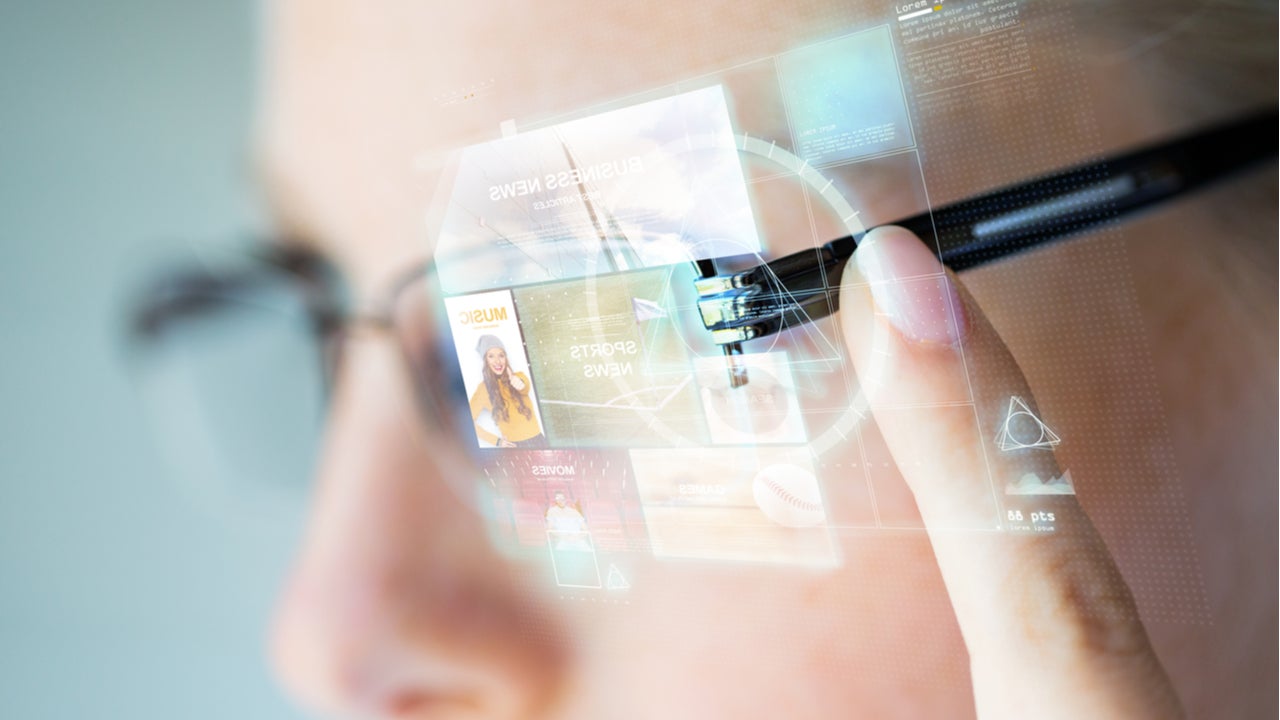
Technology Trends
Listed below are the key technology trends impacting the smart glasses industry, as identified by GlobalData.
AR smart glasses
From first-person imaging to enhanced travel directions, facial recognition, and health monitoring, AR is driving the penetration of smart glasses into multiple areas of the internet-connected society, especially in enterprises. Google, Seiko Epson, Toshiba, and Vuzix are leading vendors of enterprise-grade AR smart glasses. On the consumer side, today’s AR smart glasses come with basic functions, such as smartphone notifications, email access, and weather updates in the users’ field of view (FOV). Google’s acquisition of North in June 2020 signalled its return to the consumer smart glasses space, while Apple and Facebook are reportedly planning to launch AR smart glasses in the next one to two years.
Microdisplays
AR smart glasses use partially transparent displays that can overlay virtual objects onto the users’ FOV. Leading display makers like Kopin, Himax, Lumus, OmniVision, and Sony are developing microdisplays that combine high pixel density and brightness with low power consumption. They are also striving to minimise the weight and cost of displays. Smaller players like Micledi, WaveOptics, and Plessey are also emerging in the market.
Audio smart glasses
Audio smart glasses, developed by companies such as Bose, Huawei, and Amazon, are primarily headphone-integrated eyewear with no heads-up display. These devices are not only relatively cheap to make, but also avoid many of the privacy concerns inherent in AR smart glasses. Conversational platforms, such as Amazon Alexa and Google Assistant, make the devices smarter by enabling two-way voice communication. However, audio smart glasses have not proven as popular as anticipated. GlobalData expects audio smart glasses to continue to underperform their AR equivalent, as the latter offers both audio and interactive visual services.
Conversational platforms
Conversational platforms such as Amazon’s Alexa and Google Assistant are becoming standard inclusions on smart glasses for hands-free operability. The Google Assistant is the most prominent conversational platform in the market, while Amazon is making big pushes with Alexa. Alongside the Alexa-powered Echo Frames, Alexa support is also available on smart glasses from Vuzix and North. Apple’s Siri has a nominal presence in the smart glasses space, mostly on devices that are compatible with its iOS operating system. Apple is working on its own smart glasses, which will incorporate Siri, but is unlikely to appear on devices made by other companies.
Custom silicon
The smartphone ecosystem has played a critical role in the evolution of AR smart glasses, but the next wave of innovation is being driven by custom silicon. Qualcomm’s Snapdragon XR1 chip, launched in October 2018, was the industry’s first AR-specific processor, offering improved battery support, lower temperatures, and impressive audio-video experience. Google’s adoption of the XR1 for the Glass Enterprise Edition 2 was driven partially by the power of the chipset, which incorporated computer vision and machine learning capabilities. Qualcomm is now testing the new XR2 platform, which promises 5G and edge computing capabilities, 3D audio, and 3K resolution for each eye. Facebook and Apple are also developing custom chips for their upcoming AR smart glasses.
How well do you really know your competitors?
Access the most comprehensive Company Profiles on the market, powered by GlobalData. Save hours of research. Gain competitive edge.

Thank you!
Your download email will arrive shortly
Not ready to buy yet? Download a free sample
We are confident about the unique quality of our Company Profiles. However, we want you to make the most beneficial decision for your business, so we offer a free sample that you can download by submitting the below form
By GlobalData5G
5G promises to address the existing data processing and transmission issues associated with 4G networks. Smart glasses vendors are working on 5G-based edge computing solutions to bring seamless AR experiences to their devices. 5G technologies should help smart glasses designers reduce their focus on storage capacity and processing power. 5G chipsets will also drive further miniaturisation of components and devices, allowing vendors to bundle more sensors into their devices and making them more versatile. 5G’s connectivity should also help smart glasses become interoperable with industrial equipment such as drones and medical devices over the next three years.
Edge computing
Given the limited storage and processing capabilities on smart glasses, they rely on smartphone-based companion apps storing user data on cloud servers. Analysing the server-stored data enables vendors to improve their services, content, and advertising. Also, access to AR content on smart glasses is facilitated by cloud servers. Owing to the cybersecurity concerns and latency issues, some vendors are exploring edge computing solutions.
Vuzix partnered with TensorMark in February 2020 to develop cloud-based facial and object recognition services for the enterprise version of its Blade smart glasses. The partnership claims to be using the advances in 5G and edge computing to improve the speed, quality, and reliability of the service. ThirdEye is working with Verizon on 5G mobile edge solutions for 3D visualisation and live AR video streaming on its enterprise-focused smart glasses.
Cybersecurity
Smart glasses are internet-connected devices and, therefore, represent a potential threat to privacy for both the wearer and those around them. Smart glasses with embedded cameras can be exploited by hackers to gather personal information such as passwords, PIN codes, emails, and text messages, and can lead to privacy infringements in public places. Audio smart glasses are also not risk-free. Advertisers can gather user data to target ads, while vendors and their third-party affiliates can eavesdrop on the wearer’s conversations.
To mitigate the privacy issues and minimise exploitation of user data, regulators in Europe and the US are compelling vendors to adopt privacy by design principles during product development and privacy as a service over the lifecycle of products.
This is an edited extract from the Smart Glasses – Thematic Research report produced by GlobalData Thematic Research.





Related Company Profiles
Qualcomm Inc
Apple Inc
Bose Corp
Google LLC
Seiko Epson Corp